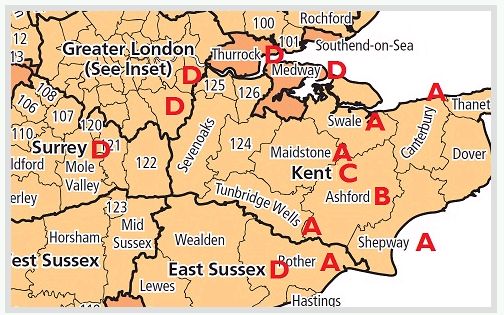Today's entry reports on the importance of consulting the correct local authorities before making an application under the Planning Act 2008.
In November, the DIRFT III rail freight application was not accepted for examination, and in December, the promoters of the Rampion windfarm application withdrew it before an acceptance decision was made. Apparently, in both cases the consultation of local authorities was an issue. What lessons can be learned from this?
Background
As part of the required pre-application consultation stages, various local authorities are required to be consulted on a forthcoming application. The Localism Act 2011 reduced the list of authorities, but also made it more complicated.
According to the Act, there are now four types of local authority that must be consulted, which are described in the Act as A, B, C and D authorities. Somewhat confusingly, 'B' authorities are the 'host' district or unitary authorities and 'C' authorities are the host county or unitary authorities, host authorities being those whose areas contain some land within the red line boundary for the application. In a two-tier area, this will mean district and county-level host authorities, and since National Park authorities also count as local authorities, it's possible for there to be three host local authorities for a particular location.
Many applications extend across local authority boundaries - indeed, they seem to have an uncanny knack of doing so. Rookery South straddles Bedford and Central Bedfordshire, for example, despite covering a fairly small area. A linear project such as an electric line or railway may cross several local authority boundaries. There could thus be several 'host', or 'B' and 'C', authorities. Host unitary authorities will count as 'B' and 'C' authorities.
The 'A' authorities are then any district or unitary authorities that share a boundary with a 'B' authority.
The 'D' authorities are any county or unitary authorities that share a boundary with a 'C' authority. It's simple, really! This map shows the A, B, C and D authorities for a project in Ashford, Kent.

Analysis
Actually, it can be expressed a bit more simply: it's the host authorities and any neighbours of any of them, except you ignore district councils neighbouring just host county councils.
As the song in the title continues, 'with a little understanding, you can find the perfect plan': since we're acting for several promoters we have created a spreadsheet where you can look up a host authority and read off the neighbouring authorities. Any land in a district or unitary authority will have the same neighbours as any other land in that authority, so you only need to work it out once. Perhaps PINS could do the same and publish it - our list would be available for only a small consideration.
I take the following lessons from what I have learned about the DIRFT and Rampion applications. Even if they didn't actually apply in those cases, they are still good lessons!
- Don't assume that PINS consulted the correct local authorities when it produced its scoping opinion,if you have one, check the list yourself;
- if your application boundary goes very close to a local authority boundary, treat the authority/ies across the boundary as host authorities just to be on the safe side; and
- even if a local authority says it doesn't want to be consulted, you must still consult it.
Note that although the Localism Act 2011 amended the Planning Act so that application documents need only be of a satisfactory standard (rather than perfect, as previously), the test for pre-application consultation remains full compliance with the terms of the Act. As the recent examples show, this is a strict test and not meeting it in a small way can result in delay and additional expense. If you have already carried out pre-application consultation but haven't made the application yet, it's still worth double-checking the local authority list.
The content of this article is intended to provide a general guide to the subject matter. Specialist advice should be sought about your specific circumstances.


